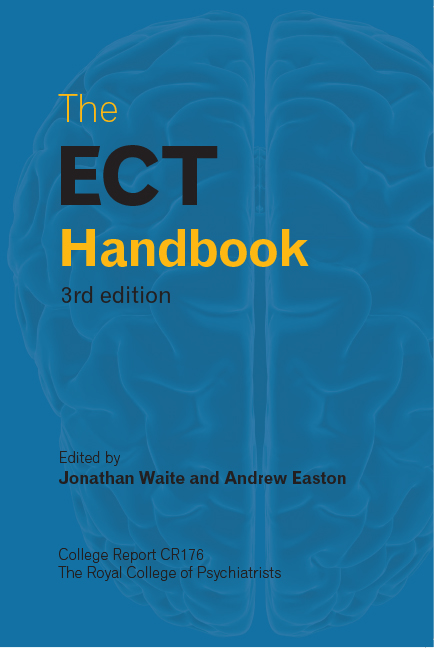Book contents
- Frontmatter
- Contents
- Abbreviations
- List of figures, tables and boxes
- List of contributors
- Preface
- Introduction: the role of ECT in contemporary psychiatry: Royal College of Psychiatrists’ Special Committee on ECT and Related Treatments
- 1 Mechanism of action of ECT
- 2 The ECT suite
- 3 Anaesthesia for ECT
- 4 ECT prescribing and practice
- 5 Psychotropic drug treatment during and after ECT
- 6 Monitoring a course of ECT
- 7 Non-cognitive adverse effects of ECT
- 8 Cognitive adverse effects of ECT
- 9 Dental issues related to ECT
- 10 Training, supervision and professional development: achieving competency
- 11 Nursing guidelines for ECT
- 12 Inspection of ECT clinics
- 13 Other brain stimulation treatments
- 14 The use of ECT in the treatment of depression
- 15 The use of ECT in the treatment of mania
- 16 The use of ECT in the treatment of schizophrenia and catatonia
- 17 The use of ECT in neuropsychiatric disorders
- 18 The use of ECT in people with intellectual disability
- 19 Safe ECT practice in people with a physical illness
- 20 ECT for older adults
- 21 The use of ECT as continuation or maintenance treatment
- 22 Consent, capacity and the law
- 23 Patients’ and carers’ perspectives on ECT
- Appendix I Out-patient declaration form
- Appendix II ECT competencies for doctors
- Appendix III Example of a job description for an ECT nurse specialist
- Appendix IV Example of a job description for an ECT nurse/ECT coordinator
- Appendix V Information for patients and carers
- Appendix VI Example of a consent form
- Appendix VII Useful contacts
- Appendix VIII Example of a certificate of incapacity
- Index
11 - Nursing guidelines for ECT
- Frontmatter
- Contents
- Abbreviations
- List of figures, tables and boxes
- List of contributors
- Preface
- Introduction: the role of ECT in contemporary psychiatry: Royal College of Psychiatrists’ Special Committee on ECT and Related Treatments
- 1 Mechanism of action of ECT
- 2 The ECT suite
- 3 Anaesthesia for ECT
- 4 ECT prescribing and practice
- 5 Psychotropic drug treatment during and after ECT
- 6 Monitoring a course of ECT
- 7 Non-cognitive adverse effects of ECT
- 8 Cognitive adverse effects of ECT
- 9 Dental issues related to ECT
- 10 Training, supervision and professional development: achieving competency
- 11 Nursing guidelines for ECT
- 12 Inspection of ECT clinics
- 13 Other brain stimulation treatments
- 14 The use of ECT in the treatment of depression
- 15 The use of ECT in the treatment of mania
- 16 The use of ECT in the treatment of schizophrenia and catatonia
- 17 The use of ECT in neuropsychiatric disorders
- 18 The use of ECT in people with intellectual disability
- 19 Safe ECT practice in people with a physical illness
- 20 ECT for older adults
- 21 The use of ECT as continuation or maintenance treatment
- 22 Consent, capacity and the law
- 23 Patients’ and carers’ perspectives on ECT
- Appendix I Out-patient declaration form
- Appendix II ECT competencies for doctors
- Appendix III Example of a job description for an ECT nurse specialist
- Appendix IV Example of a job description for an ECT nurse/ECT coordinator
- Appendix V Information for patients and carers
- Appendix VI Example of a consent form
- Appendix VII Useful contacts
- Appendix VIII Example of a certificate of incapacity
- Index
Summary
The responsibilities of the ECT nurse specialist have continued to expand and develop over recent years. It is now widely recognised that this is an expert role which is pivotal within the ECT core team. This chapter outlines the guidelines for best practice and describes the main responsibilities of the nurses involved in the ECT process (see also Appendices III and IV).
The role and responsibilities of the ward nurse
The ward nurse should be able to provide care and support for both the patient and their relatives before and after treatment on the ward. They should be familiar with the requirements for the treatment in order for them to accurately and sensitively inform both the patient and their relatives of what to expect during the course of treatment. The ward nurse requires the following knowledge and skills:
• A good knowledge of current national guidelines and standards, including ECTAS (Cresswell et al, 2012), SEAN (2010), Royal College of Nursing (Finch, 2005), Royal College of Psychiatrists (Waite & Easton, 2013), Association of Anaesthetists of Great Britain and Ireland (2010), NICE (2003) and Nursing and Midwifery Council (2008).
• A good working knowledge of local ECT guidelines, protocols and policies.
• A good working knowledge of the requirements of legal status and consent to treatment, including prescription.
• A good basic knowledge of the following:
• referral process
• indications for ECT
• risks and benefits of ECT
• contraindications to ECT
• pre-ECT investigations and significance of results
• potential drug interactions with ECT
• preparation of the patient for ECT
• requirements for day-case/out-patient ECT
• possible side-effects of ECT
• the anaesthetic procedure for ECT including risks and potential side-effects
• the ECT procedure
• unilateral and bilateral ECT differences, risks and benefits
• continuation or maintenance ECT
• drugs used in ECT and their potential side-effects
• post-ECT observations on return to the ward
• the review process between treatments
• protocol for patients going out on pass following ECT.
- Type
- Chapter
- Information
- The ECT Handbook , pp. 99 - 108Publisher: Royal College of PsychiatristsFirst published in: 2017



